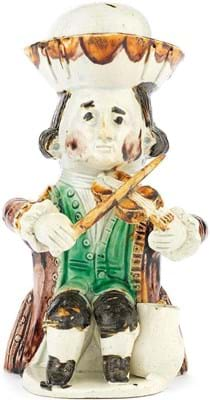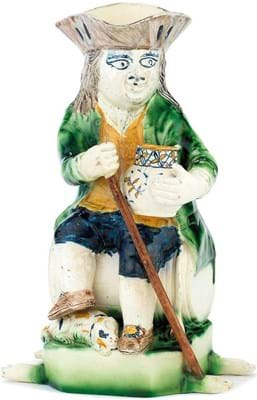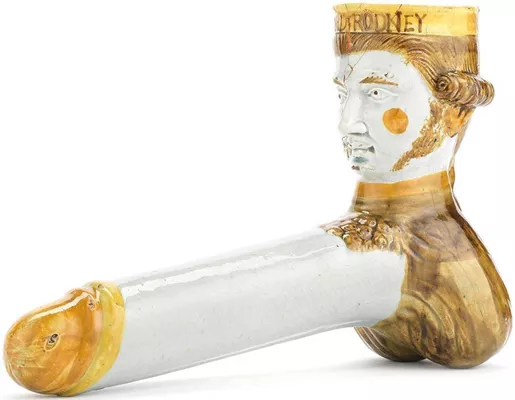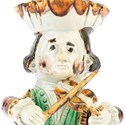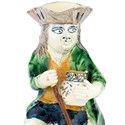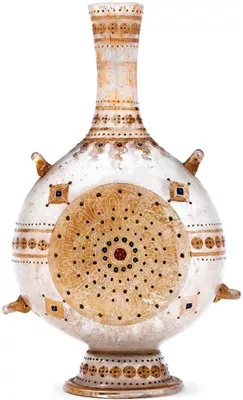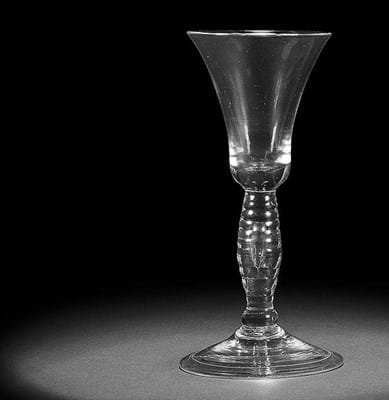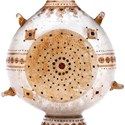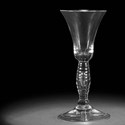For British ceramics enthusiasts Bonhams (27.5/25/20/14.5% buyer’s premium) offered a pre-Christmas feast on December 15 from its Knightsbridge rooms.
A 194-lot catalogue comprising two single-owner collections of early porcelain from the Worcester factory was followed in the afternoon by a 131-lot mixed-owner sale of glass, British pottery and porcelain.
The afternoon’s varied selection of material spanning over two centuries of British ceramic production included a 38-lot collection of Staffordshire pottery toby jugs that proved to be the financial high point of the day’s offerings.
Not only did all bar two lots sell, the collection provided five of the sale’s highest prices and set a new auction high for this class of British pottery.
The collection had been assembled by the late James and Timmey Challenger of Chicago over a period of some years. Some of the couple’s examples had been acquired directly at auction, others via the trade.
“There was a mixture of dealers and collectors buying the jugs… Many of the dealers were bidding on most lots but were often pipped to the post by collectors,” said Bonhams’ specialist Jim Peake.
In terms of nationality, UK and US buyers were major players (the toby jugs market being very much UK centred) but, interestingly, Peake noted that they did have a few buyers and bidders from Portugal.
“The Portuguese made many fine toby jugs to emulate the English versions in the late 18th and early 19th century and there is a dedicated following of collectors of Portuguese jugs over there where they can make many thousands of euros in Portuguese auctions.”
Admiral buoyant
The star turn of the Challenger collection was the 11½in (29cm) high Admiral Lord Rodney jug, c.1785, pictured on this week’s front page.
A dozen such Rodney jugs, the largest models in the Midshipman group, are recorded. Two of them, sold at auction in Sotheby’s and Phillips in 1967 and 1989 respectively, are inscribed J Marsh Folley which is thought to be for the Foley-based Staffordshire potter Jacob Marsh to whom this group is attributed.
A third Lord Rodney jug was sold two years ago by Bonhams in these same rooms for a premium-inclusive £21,250. Bonhams had guided the Challenger jug at a similar amount – £15,000- 25,000 – only to see it pursued on the day to £65,000. It came for sale from the US, so – in addition to the buyer’s premium – a further 5% import VAT was due on the hammer price.
This sum beats the previous auction high for a Tailor Toby from the Midshipman group which Bonhams sold in 2009 for £36,000 including premium. Bidding came from phones and commissions in the UK and US but ultimately it was a battle between two determined bidders. The jug will be staying in the UK, said Peake.
The second-highest price in the Challenger property was the £28,000 bid for another Midshipman group jug, an example of the smaller variant measuring 7¾in (17.5cm) high modelled as a man seated playing a fiddle.
This piece had an earlier provenance to Lord Mackintosh of Halifax who was a keen toby jug collector. It was last sold at auction by Sotheby’s in 1988 for £26,000 which was a record for a toby jug that stood until Bonhams sold its jug in 2009. The jug is thought to be the only known Fiddler example to retain its original cover.
A rare Tipsy Man toby had also formerly been part of the Mackintosh collection and had sold at Sotheby’s in 1967. Modelled in creamware without a base, with the feet of the chair on which the jolly toper is seated forming the supports, the 11in (27cm) high jug sold for £15,000.
Another creamware rarity of unusual form was a 10in (25cm) high Admiral Lord Howe jug of c.1785. The figure is shown seated on a barrel with a recumbent spaniel at his feet and has a base applied with four pegs each pierced with a hole. The exact purpose for the pegs is uncertain but was presumably intended to secure the jug. This sold for £6200, more than double the £2000- 3000 top guide.
Not all the Challenger lots performed at this level. A dozen lots went for prices in the £1000-3000 bracket and a further 10 sold for sums under £1000.

This 10in (25.5cm) high bearded toby of traditional form dated to c.1800 and inscribed Joseph Marttain Burslam was among the more affordable examples in the Bonhams auction, selling for £1900.
Rodney prominent
Outside the Challenger properties, another Lord Rodney-related pottery piece achieved a strong price. This was a novelty Prattware stirrup cup from c.1800 with the handle shaped as a phallus and Rodney’s head forming the cup. This early 19th century piece was probably intended for use in a drinking game and somersaulted over its £500-1000 guide to take £7000.
The sale’s other strong Staffordshire pottery result was the £18,000 paid for a Polito’s Menagerie group (pictured and discussed on page 12).
The other main highlight of this auction featured among the 30-odd lots of English and Continental Glass that opened the sale. The first lot, a late 15th or early 16th century Venetian enamelled pilgrim glass flask, sold just over the upper end of its £20,000-30,000 guide for £34,000.
The 12¼in (31cm) high flask, which is painted in enamels and gilt with two large medallions formed of lappets, bands of dots and roundels, belongs to a distinct group of similarly decorated flasks with flattened ovoid bodies whose form is probably based on earlier 13th century Islamic prototypes. A virtually identical example, possibly the pair to this one, was sold by Sotheby’s in 2017 for £68,750 including premium.
It was quite a season for Venetian glass for this department. In September it offered 33 lots from the 19th century collection of Lady Maria Elisabeth August Cartwright which produced some very strong prices (see ATG No 2462). The Cartwright collection also featured a Venetian flask of similar date but more conventional circular form and armorial decoration that realised £25,000.
In the English drinking glasses, there was a strong price for an early, c.1725-30, bell bowled wine glass which had an unusual teared and annulated swelling stem, a form that is apparently unrecorded. It sold for £3600.



